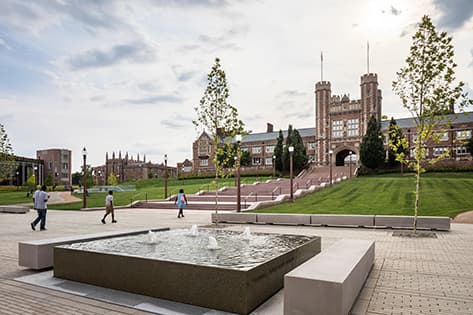Electrochemical innovation offers chemical-free solution to assist in wastewater reuse
Kaichao Yang and Zhen He developed an electrochemical process that softens water, disinfects pathogens and benefits reverse osmosis systems used for advanced water treatment

As cities worldwide face increasing water scarcity, wastewater reuse is essential to sustainable water management. A new study from researchers at Washington University in St. Louis introduces a chemical-free electrochemical treatment system that simultaneously softens water and produces disinfectants, without the need for added chemicals.
The study was led by Kaichao Yang, a doctoral student in the lab of Zhen (Jason) He, the Laura & William Jens Professor in the Department of Energy, Environmental & Chemical Engineering in the McKelvey School of Engineering at WashU. The study was published April 15, 2025 in Desalination.
The study outlines a dual-function electrochemical process that addresses two critical issues in wastewater treatment: inorganic scaling caused by calcium and magnesium ions and microbial contamination. The system uses electricity to drive two key reactions in separate chambers: one that generates hydroxide ions to remove hardness-causing minerals through precipitation, and another that forms chloramine and hydrogen ions for disinfection and pH adjustment. After the process, the treated water is softened, disinfected and ready for further purification through reverse osmosis (RO) membranes.
“Membrane technologies like RO are critical for wastewater reuse,” Yang said. “However, membrane fouling issues can significantly decrease RO performance. Our study developed an electrochemical approach to achieve chemical-free water softening and disinfection that would help prevent these issues.”
The team tested the system using real secondary effluent from a local wastewater treatment plant. In their experiments, they achieved over 80% removal of calcium ions and more than 50% removal of magnesium ions. The system also reduced total coliform and E. coli by more than 99.999% and 99.99%, respectively, bringing microbial levels below detection limits.
The researchers also evaluated the system’s long-term performance. Over 50 treatment cycles, it maintained consistent effectiveness in water softening and disinfection. Although mineral scaling on the cathode did begin to reduce performance after extended use, the team was able to restore the system’s function using a mild acid wash, enabling at least 30 additional cycles without loss of performance.
“Cathode scaling would affect the electrochemical softening performance in long-term operation,” Yang said. “We used acidic washing to regenerate the cathode.”
The final treated water met U.S. Environmental Protection Agency guidelines for pH and chlorine residuals, with a neutral pH around 7 and about 2.8 mg/L of chloramine.
Yang also noted this system could be even more effective under different conditions.
“We demonstrated the feasibility of using this system to treat secondary effluent,” Yang said. “This system could work better for treating wastewater with higher conductivity.”
Looking ahead, the team plans to explore how the system can be integrated with a full-scale RO system to create a more comprehensive wastewater reuse solution.
“This study developed a chemical-free process that can serve as a pretreatment step to control scaling/fouling in the subsequent RO treatment in wastewater reuse,” Yang said.
Yang K, He Z. Electrochemically assisted water softening with disinfectant production for wastewater reuse. Desalination, online April 15, 2025. DOI: https://doi.org/10.1016/j.desal.2024.118466.
This paper was supported by NPRP grant # [NPRP13S-0109- 200029] from the Qatar National Research Fund (a member of Qatar Foundation), a faculty startup fund at Washington University in St. Louis, and the WashU Institute of Materials Science & Engineering (IMSE) Exploratory Research Grant.




